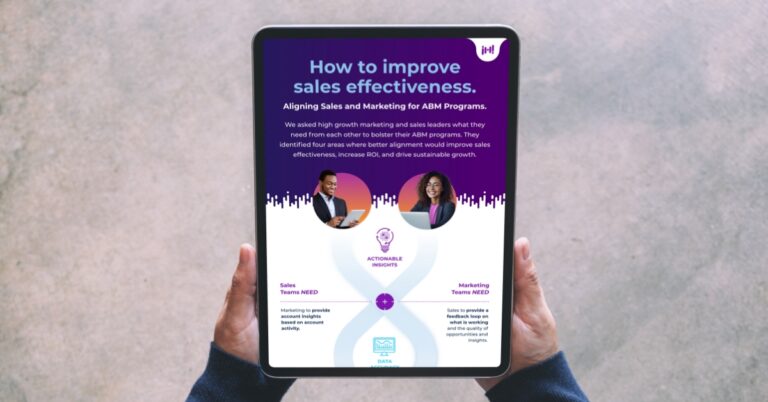If you’re not integrating data from your digital experiences to advance your ABM strategy, it’s time to start. Here’s how to best leverage six common digital tactics for ABM.
New to account based marketing? Start here.
Why should marketers employ a mix of digital experiences for ABM?
For many B2B marketers, account based marketing—or ABM—means targeting key accounts identified by sales with personalized nurtures designed to bring in better leads. While this alignment between marketing and sales teams was revolutionary five years ago, today’s most sophisticated ABM programs go further.
In fact, Terminus’s annual State of ABM Report found that while 42% of teams early in the ABM journey indicated that lead gen was a top performance metric for their ABM program, teams with mature ABM programs identified new business generation, customer retention and pipeline acceleration as their top indicators of success. In other words, those who have been doing account based marketing for a while understand the power of this strategy for growth.
The key to driving these results is the intelligent gathering and continual exchange of data between your marketing and sales organizations. This creates a truly symbiotic relationship that helps marketing target and better serve buying team members at target accounts, while giving sales the context they need to start and sustain conversations with them. (Learn how to foster this relationship and lay the groundwork for highly effective ABM programs in our ABM Foundations video series.)
Done well, digital experiences advance your ABM strategy by:
- Driving engagement. Personalized content helps you increase engagement and build deeper relationships with the individuals within target accounts.
- Delivering insights. Using a variety of digital experiences for ABM allows you to glean important insights into the interests and buying stage of those prospects—providing the context necessary to effectively personalize sales outreach.
You don’t need purpose-built ABM software to reap the benefits of digital experiences for ABM. But you do need to be more intentional about your favorite tactics and implement practices that promote two-way information-sharing between marketing and sales teams.
Here’s how to adapt your top digital marketing tactics to build a smarter, more integrated ABM program.
Social media for ABM.
While the point of ABM is focusing on accounts, the key to making inroads with those accounts is truly understanding what matters to the people inside them. Social media is an excellent tool for this sort of discovery, but getting the insights you need takes both patience and effort. Fortunately, there are many tools available to help! Social listening tools enable you to monitor conversations for specific topics, such as your company or solution name, industry initiatives, and hashtags. Twitter lets you create lists of target accounts (and key prospects within them) so you can more easily follow their conversations. And, social aggregators, such as Hootsuite and Sprinklr, allow you to pull together activity by specified individuals across platforms to give you a fuller view of their concerns.
Putting it in practice.
The first step in using social media for more effective account based marketing is to focus your listening on target accounts. Social listening can help you identify the appropriate targets within your named accounts (if Martha is talking a lot about a pain point you solve, she’s likely a key stakeholder in the buying group for your solution), and learn what these stakeholders care about. This information can then help you fine tune messaging for these accounts, identify and create content that will resonate, and provide fodder for personalized outreach from sales.
Once you have a strong sense of what your audience cares about, you can join the conversation, both by introducing topics (and resources) on your feeds that speak to their top issues, and by engaging directly with stakeholders from top accounts in response to their posts. This is not a time to pitch your solution, but rather to create positive experiences for the prospect with your brand around topics they care about.
Paid media for ABM.
For most organizations, paid media is the workhorse of demand gen, building awareness through impressions and driving traffic to your content and, ultimately, your lead gen forms. Your paid media also amplifies messages prospects are receiving via other channels, including your organic social, email nurtures, and direct outreach from sales.
Many social media channels now offer tools focused on ABM. For example, LinkedIn has an account-based marketing campaign tool and Facebook and Twitter allow brands to target advertising at “custom audiences” created by uploading email addresses, phone numbers, and user handles. But the real bang for your media buck comes through publishers and ad platforms, such as TechTarget and Demandbase, that not only enable you to target your named accounts with personalized ad content, but also provide a wealth of actionable insights about your audience.
Putting it in practice.
It’s not enough to simply put your message in front of your target audience. To get the most out of these platforms, it’s essential to understand the personas that make up your target buying group, and have messaging that is tailored to each. (It goes without saying that your paid media strategy should include continuous testing and optimization of this messaging. See how taking this approach with a rapid response campaign helped our customer reach more than 400 targeted accounts in a very short time frame—with 20% of new prospects opting in to being contacted by the company.)
Equally critical is having engaging high-quality content for each stage of the buyer’s journey. This means a combination of quick, entertaining or educational content, like blogs, infographics, and short videos; opportunities to learn more through webinars, interactive content, and eBooks; and content that helps convert, such as case studies, comparison charts, demos and offers.
This breadth of content also provides valuable information about where your target prospects are at in the buying journey. If an account is responding to progressively more detailed content pieces, that’s a good sign they are further down the funnel.
Go deeper with Best Practices for Using Paid Media in ABM Programs.
Website personalization for ABM.
Of the thousands of users that visit your site, most are anonymous. Website personalization—displaying customized messaging and images based on data about the visitor’s behavior, intent, role, firmographics or funnel stage—increases the chances that visitors will connect with your message and explore more of your content. It can help drive anonymous viewers to convert and become known, so you can start including them in your email nurtures. It also makes for better, more relevant experiences for known visitors and customers as they progress along the buying journey.
Putting it in practice.
If you are creating personalized ads for top accounts, you absolutely should be personalizing your website experience for them, too. Even just customizing the messaging and imagery in your marquee creates a significantly more cohesive experience for the visitor. Setting up personalization for listed accounts on your website also enables you to get helpful insights about those visitors, even when they are not known, which in turn can lead to better content planning, targeting and retargeting campaigns, and intelligence for your sales organization. It also allows you to let your sales organization know when someone from named accounts visits your site, and what they interact with there.
Interactive content for ABM.
We all know that content is incredibly important—king, even—when it comes to keeping prospects engaged with your brand during the weeks to months it takes to move from dawning awareness of your company or solution to being ready to hear from your sales team. At the same time, buyers are inundated with content, making it incredibly hard to catch and hold their attention.
Taking normally static or linear content—such as brochures, infographics, white papers and even demos—and adding interactive elements that bring the information to life and enable users to choose their own pathway through it, is a great way to provide more engaging and personalized experiences for potential customers. There are many tools and services that make it easy for marketers to create interactive experiences and supply brands with a wealth of insights to help hone messaging, improve campaigns, understand intent and help sales personalize their outreach. For instance, interactive content created with tools like Ceros and Ion not only make the content more interesting, but provide data such as time on page, user selections, and more. Chatbots like Drift enable brands to be more responsive and streamline the customer experience while capturing very granular information about their needs.
Putting it in practice.
Interactivity for the sake of interactivity gets old fast. To put interactive content to best use in your ABM strategy, consider which interactions will create the most engaging experiences while delivering the most actionable insights about your target accounts. For example:
- A branching or a choose-your-own-adventure-style experience enables prospects to customize their experience with your content—while capturing information about their preferred solutions or features that can help you improve segmenting and provide more personalized follow-up.
- A chatbot that offers users a choice of viewing an infographic, reading a report, registering for a webinar or setting up a demo can help them get the resources they need without digging through your site—and provides you with a strong indicator of where they are in the buyer’s journey.
- A report that allows users to input their own responses to survey questions before displaying industry benchmarks can not only put the data into context for the user (and invoke a sense of FOMO), but supplies your sales team with key data about the prospect’s needs before the first conversation.
Virtual/hybrid events for ABM.
It’s no secret at this point that virtual events are treasure troves of user data. Since account-based marketing thrives on that kind of data, it makes perfect sense that ABM and virtual/hybrid events are mutually beneficial. Incorporating in-person events into your ABM strategy usually involves creating specialized experiences for target accounts within the larger event—but these experiences can still get lost in the shuffle. With a virtual or hybrid event, you can center an entire event around your target accounts, creating a better experience for them and better data for you.
Putting it in practice.
Like interactive content, virtual and hybrid events allow you to deliver hyper-personalized experiences to prospects from your target accounts, while bringing you a wealth of data about how these prospects engage with that content before, during and after the event.
Here are some of the ways to use virtual and hybrid events to advance your ABM strategy:
- Before the event, use engagement data from paid media and interactive content to inform session topics, tracks, or even an entire virtual event focused on the needs of your top accounts.
- During the event, host VIP sessions for high-priority accounts that feature up-scale experiences, provide access to certain resources, or give an opportunity to provide feedback on your product or solution.
- After the event, use event interaction data to surface intent and inform follow-up. An engagement scoring system, created during the planning stage and based on the number and quality of interactions (attendance, sessions viewed, etc.), can help sales quickly identify the most engaged leads and accounts from the event. Make sure to also pass on data about session topics, discussion board participation, experiential sessions attended, and any other interactions taken by these highly engaged participants; all of this can help inform which assets to follow up with, be fodder for the perfect email subject line, or present an opportunity for a relevant and memorable digital gift.
Gifting for ABM.
Okay, so gifting isn’t exactly a digital experience, but it is a very powerful way to augment your other digital experiences to create personal, memorable engagement with prospects. The right gift—at the right moment—may be just the thing to cause that warm lead to accept the sales call. When used as part of an email outreach, thoughtful gifting creates a human connection, can help boost open and engagement rates, and increases conversion and response rates.
Putting it in practice.
Like other aspects of ABM, successful use of gifting takes time and attention from your sales team. Sending a gift that doesn’t resonate to a prospect that isn’t ready to engage further is a waste of time and money, and is considered spam. Instead, sales should use data from other digital marketing tactics mentioned here to identify leads that are ready to take the next step, and then pave the path to a sales meeting with a thoughtful gift that reflects knowledge of the lead’s hobbies or interests.
The Iron Horse insight.
The true power of ABM lies in using the data from interactions to create ever-more relevant content for and engagement with key stakeholders in your target accounts—and to set up your sales team to intercept prospects at the optimal point in their journey with content and offers that are tuned to their specific needs. If you’re not looking at the data generated by these tactics in an integrated way and with ABM in mind, you’ll only hit the first part of this equation. To actually drive growth with your ABM strategy, it’s imperative that you have a process and tools by which your marketing team can hand off this intelligence to sales (and for sales to pass intelligence back to marketing), and that your sales team is equipped with knowledge and resources to make best use of it.



